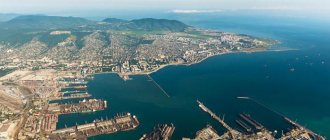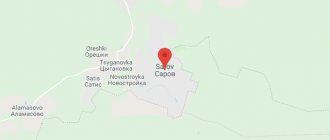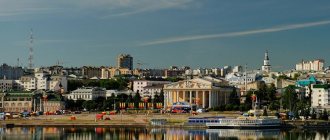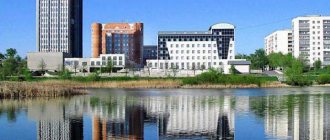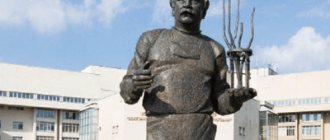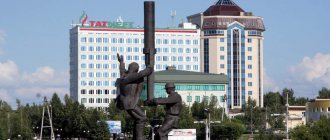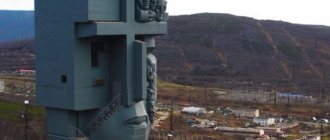Magadan is the capital of the Magadan region, the northernmost on the map of the Russian Federation. A young city built during the years of Soviet power, this year on July 14 it turned 80 years old. Before answering the question of where Magadan is located, you need to get acquainted with its history, which is truly complicated.
Population
Magadan's population has declined significantly since Soviet times. According to the first official data available to researchers, in 1939 there were 27,313 people living in the city.
After this, for many years the dynamics were extremely positive. Already in 1956, the population of the city of Magadan exceeded 50 thousand people. In 1973, 101 thousand inhabitants were already recorded. In 1989, the population of Magadan exceeded 150,000. The record was currently set in 1991. At that time, 155 thousand people officially lived in this city.
Negative dynamics
After this, the reverse negative dynamics began. The population of Magadan began to decline inexorably over the years. This trend continued until 2002. Throughout the 90s, people left Magadan en masse, but no one came to replace them. The population of Magadan residents by 2002 was only 99,399 people. After this, positive dynamics began. As throughout the country, in the 2000s the situation in this regional center began to improve.
Until 2007, the population and the number of residents of Magadan grew. True, not by much, reaching only 100,200 people. Then the decline began again, which continued until recently. After reaching its lowest point in 2016 (then the population of Magadan was 92,081 people), a positive trend has been observed in the last couple of years. Experts note growth and positive dynamics.
The total population of Magadan today is 92,782 people.
[edit] Links
- Local news agencies: MagadanMedia; Kolyma.ru; In Magadan; rest…
- An Italian's note about Magadan and the reaction of local hamsters to it. His notes about the route to Yakutsk: the first part, the second.
- “How bloggers flew in a helicopter” or “Magadan from a bird’s eye view”: , , , , .
- Notes from some bloggers about the trip to Magadan: Artemy Lebedev; Sergey Dolya: , , , , , , (about the region); Dima Balakirev/on YAP-e, (about the region); Alexey Nasedkin, (about the region); Sergey Filinin; Anna Sidorova: , , , (about the region); Alexander Cheban: , ; Pavel Kremnev; Alexey Kamerzanov, 13k.
- Top bloggers of the region, with photographs of the city/surrounding area and events: Alexander Krylov; Ilya Kovyakin: photo/video from copter; Evgeniy Radchenko; Anton Afanasyev.
- Trips of the Drom.ru portal: To Magadan: Lada Granta Blog - , , , , , , , ; Blog Renault Duster - , , , , .| From Magadan with a stop in Oymyakon in winter 2013: Lada Granta Blog - , , , , , , , , ; Blog Renault Duster - , , , , .
- Auto/motor travel: Stories about trips to/from the region; Trip reports on local forum; A girl’s trip from St. Petersburg to Magadan, on an IZH-Planet-5 motorcycle; LongWay2Magadan; A trip to Magadan in a BMW X5; Again to Magadan on the KTM-640 Enduro motorcycle - 2015; Magadan 2011; Going to Magadan 2015; Along the BAM on the R1200GS or motorcycle trip Irkutsk-Magadan 2013: , ; I'm going to Magadan 2013!.
- Subject on VKontakte: MGDN Magadan; MAGADAN + KOLYMA; Priznavashki Magadan; Dating Magadan; Overheard Magadan✔.
- Bayans about the city: “You are from Magadan if...”, About Magadan.
- Memes related to the city: “Sunny Magadan”; About prisons; Going to Magadan. Cafe "U Beaver"; Typical Magadan.
- Panoramas of Magadan streets from: Google, Yandex; Panoramas of the city and region.
- Local 2GIS; Magadan Directory - “Pioneer”: Android|iOS; City transport routes “Go2bus”: Online|Android|iOS; WhatsApp groups of the city.
- Webcams: View of Cathedral Square; Ski resort website: view of the territory.
- Local auto forum; Magadan off-road extreme club Nord Trophy; Russian license plates - Magadan region.
- Airport website with flight schedules; Management of the Kolyma highway and up-to-date information on the condition of the road.
- Local photo gallery; City life on Instagram.
- Mistakes of tourists when traveling around the Magadan region; About industrial tourism; Visitor's report on fishing in the region; Consequences of winter fishing: , .
- Encyclopedia of the city and region; Electronic library for four-eyed nerds; A guide to your native country, created by its residents.
- NTV: “Let's go, let's eat!”; T/k "Culture". Broadcast of “Letters from the Province”: Magadan; Yagodnoye village; City on YouTube
.
City `s history
The Russian government began to show interest in the Okhotsk coast and Chukotka from the beginning of the 19th century, when the authorities decided to intensify their search for new deposits. They were especially interested in precious metals. Therefore, expeditions were sent to the outlying regions of Russia, but it was not possible to find a lot of gold, so much that it could be mined on an industrial scale.
Finally, in 1915, in the area of the Srednekan River, prospector Shafigullin, who had the nickname Boriska and traditionally worked alone, found the first gold in Kolyma.
In 1926, an expedition of Soviet geologist Sergei Obruchev arrived at this place to assess the conditions of the location of this precious metal. An expedition began to study Kolyma in detail, led two years later by geologist Yuri Bilibin. Detailed information about the economy of this region was collected by the Molody hydrographic expedition. It was these researchers who managed to discover Nagaev Bay as the most convenient for establishing a port and starting to build roads from this place.
In 1928, an official decision was made to build the East Even cultural base, and the next year they began to build houses for employees, a veterinary center, a secondary school, a boarding school building and a hospital. It is 1929 that is considered the year of the founding of Magadan, which at that time still had the status of a village. It became a city 10 years later.
From 1930 to 1934, Magadan was considered the center of the Okhotsk-Even National Okrug, and from 1954 to the present, it has been the center of the founded Magadan Region.
Map
| Magadan: maps |
Magadan: photo from space (Google Maps) Magadan: photo from space (Microsoft Virtual Earth)
| Magadan. Nearest cities. Distances in km. on the map (in brackets along roads) + direction. Using the hyperlink in the distance , you can get the route (information courtesy of the AutoTransInfo website) | |||
| 1 | Ola | 27 (30) | IN |
| 2 | Tent | 60 (82) | WITH |
| 3 | Ust-Omchug | 184 (262) | WITH |
| 4 | Yagodnoe | 334 (533) | WITH |
| 5 | Seymchan | 383 (490) | WITH |
| 6 | Susuman | 384 (581) | WITH |
a brief description of
Located 7110 km east of Moscow, on the shore of Nagaev Bay in the Sea of Okhotsk, on permafrost and in a zone of increased seismicity, 1810 km from the railway. Khabarovsk station.
Seaport, the largest in the northeast of Russia. The Kolyma Highway begins from Magadan.
The climate is sharply continental and harsh. The average temperature in January is -17, in July +11. Precipitation is 530 mm per year.
Territory (sq. km): 1216
Information about the city of Magadan on the Russian Wikipedia website
Historical sketch
The construction of Magadan began in 1929 in connection with the development of natural resources in the North-East of the USSR (gold mining in the Kolyma basin). The name Magadan is from Even Mongodan “sea sediments; fin,” was the name of one of the rivers that flowed near the site of the city’s origin. A less convincing version connects the name with the name of Even Magda, on the site of whose camp the city eventually grew.
In 1930-50 Magadan was the control center of the North-Eastern forced labor camps of the NKVD of the USSR.
The city since 1939. Since 1953 the center of the Magadan region.
In 2000, the city included Armansky, Olsky and Khasynsky urban districts instead of the Olsky and Khasynsky districts of the region. In 2002, the Olsky and Khasynsky districts were restored.
Municipal indicators
| Index | 1990 | 1999 | 2001 | 2003 | 2005 |
| Demography | |||||
| Number of births, per 1000 population | 13.8 | 8.5 | 8.8 | 11.7 | 10.7 |
| Number of deaths, per 1000 population | 5.8 | 8.9 | 9.3 | 11.5 | 12.5 |
| Natural increase (decrease), per 1000 population | 8 | -0.4 | -0.5 | 0.2 | -1.8 |
| Standard of living of the population and social sphere | |||||
| Average monthly nominal accrued wages, rub. | 0.611 | 3288 | 5808 | 9448.5 | 14684.46 |
| Average housing area per inhabitant (at the end of the year), sq.m. | 15.7 | 19 | 19 | 22.5 | 22.7 |
| Number of preschool institutions, pcs. | 71 | 30 | 30 | 30 | 30 |
| Number of children in preschool institutions, thousand people | 12.8 | 4.2 | 4.5 | 4.7 | 5.1 |
| Enrollment of children in preschool educational institutions (at the end of the year), as a percentage of the number of children of the corresponding age, % | 77 | 76.5 | |||
| Number of daytime educational institutions (at the beginning of the school year), pcs. | 31 | 28 | 27 | 27 | 25 |
| Number of students in daytime educational institutions, thousand people | 23.4 | 16.8 | 14.8 | 13.1 | 11.2 |
| Number of doctors, people. | 969 | 757 | 726 | 738 | 737 |
| Number of nursing staff, people. | 2068 | 1729 | 1856 | 1875 | 1872 |
| Number of hospital institutions, pcs. | 10 | 14 | 14 | 14 | 14 |
| Number of hospital beds, thousand units | 2.5 | 2.1 | 2.1 | 2.1 | 2.1 |
| Number of medical outpatient clinics, pcs. | 24 | 29 | 29 | 34 | 33 |
| Capacity of medical outpatient clinics, visits per shift, thousand units. | 3.5 | 3.5 | 3.2 | 3.3 | 3.7 |
| Number of registered crimes, pcs. | 3807 | 3804 | 3405 | 2231 | 2562 |
| Persons who committed crimes were identified, persons. | 1836 | 2159 | 952 | 1118 | |
| Economy, industry | |||||
| Number of enterprises and organizations (at the end of the year), pcs. | 6094 | 6795 | 7271 | 7723 | |
| Number of operating enterprises by type of activity: mining (at the end of the year), pcs. | 3 | ||||
| Number of operating enterprises by type of activity: manufacturing (at the end of the year), pcs. | 40 | ||||
| Number of operating enterprises by type of activity production and distribution of electricity, gas and water (at the end of the year), pcs. | 13 | ||||
| Volume of shipped goods of own production by type of mining (in actual prices), million rubles. | 15.1 | ||||
| Volume of shipped goods of own production by type of manufacturing (in actual prices), million rubles. | 606.2 | ||||
| Volume of shipped goods of own production by type of production and distribution of electricity, gas and water (in actual current prices), million rubles. | 1860.8 | ||||
| Construction | |||||
| Volume of work performed by type of activity “Construction” (until 2004 - volume of work performed under construction contracts), million rubles. | 0.202 | 202.1 | 402 | 522.6 | 803.2 |
| Commissioning of residential buildings, thousand sq.m. of total area | 87 | 7 | 6.3 | 7.1 | 7.1 |
| Commissioning of residential buildings, apartments | 1407 | 106 | 89 | 125 | 58 |
| Commissioning of preschool institutions, places | 0 | 0 | 0 | 0 | 0 |
| Commissioning of educational institutions, places | 0 | 0 | 0 | 0 | 0 |
| Commissioning of hospital facilities, beds | 0 | 0 | 0 | 0 | 0 |
| Commissioning of outpatient clinics, visits per shift | 100 | 0 | 0 | 0 | 0 |
| Transport | |||||
| Number of bus routes (in intracity traffic), pcs. | 25 | 17 | 17 | 18 | 1 |
| Number of passengers transported by buses per year (in intracity traffic), million people. | 45.2 | 31.2 | 28 | 27.2 | 9.8 |
| Connection | |||||
| Number of telephone sets of the city public telephone network, thousand units. | 36.9 | 37.6 | 39 | 34.8 | 39.6 |
| Number of residential telephone sets of the city public telephone network, thousand units. | 18.3 | 24.7 | 26.2 | 27.2 | 30.8 |
| Number of payphones of the city telephone network (including universal ones), pcs. | 297 | 299 | |||
| Trade and services to the population | |||||
| Retail trade turnover (in actual prices), million rubles. | 0.5 | 1541.2 | 2516.6 | 3582.1 | 4942.9 |
| Retail trade turnover (in actual prices), per capita, rub. | 2.9 | 11865 | 19433 | 33540 | 46146.6 |
| Index of physical volume of retail trade turnover, % compared to the previous year | 111.6 | 111.2 | |||
| Index of physical volume of public catering turnover, % compared to the previous year | 109.7 | 104.3 | |||
| Number of stores, pavilions (at the end of the year), pcs. | 36 | 30 | |||
| Sales area of shops, pavilions (at the end of the year), sq.m. | 4990 | 4489 | |||
| Volume of paid services to the population (in actual prices), million rubles. | 0.101 | 917.9 | 1540.6 | 2526.3 | 3393.1 |
| Volume of paid services to the population (in actual prices), per capita, rub. | 0.6 | 7045 | 11897 | 23654 | 31681.8 |
| Volume of household services to the population (in actual prices), million rubles. | 0.021 | 28.6 | 37.6 | 43.1 | 77.1 |
| Volume of household services to the population (in actual prices), per capita, rub. | 0.126 | 219.5 | 290.4 | 403.2 | 720.3 |
| Investments | |||||
| Investments in fixed assets (in actual prices), million rubles. | 0.309 | 422.8 | 679.5 | 1116.1 | 1439.2 |
| Share of investments in fixed assets financed from budgetary funds in the total volume of investments, % | 97.6 | 12.7 | 26.2 | 15.4 | 26 |
Data sources:
- Regions of Russia. Main characteristics of the constituent entities of the Russian Federation: statistical collection. Goskomstat of Russia. - M:, 2003.
- Regions of Russia. Basic socio-economic indicators of cities. Statistical collection. Rosstat. - M:, 2005. p. 365
- Regions of Russia. Basic socio-economic indicators of cities. 2006. Statistical collection. Rosstat. - M:, 2006. p. 361
Culture, science, education
North-Eastern Complex Research Institute and Institute of Biological Problems of the North. Far Eastern Scientific Center of the Russian Academy of Sciences, Research Institute of Gold and Rare Metals, Zonal Research Institute of Agriculture of the North-East and a branch of the Pacific Institute of Fisheries and Oceanography.
International Pedagogical University. Branches: Khabarovsk Technical University, Moscow Law Institute.
Theatres: musical drama, puppet theater.
Museum of Local Lore.
Universities of the city
Magadan Institute of Economics - branch of the St. Petersburg Academy of Management and Economics
685000, Magadan, Proletarskaya st., 11
Magadan branch of the Moscow State Law Academy named after. O.E. Kutafina
685007, Magadan, Shkolny lane, 3
Magadan branch of the Russian Academy of Entrepreneurship
685000, Magadan, Portovaya st., 8
Magadan branch of the Modern Humanitarian Academy
685000, Magadan, st. Karla Marksa, 11
Russian State University for the Humanities (Magadan branch)
685000, Magadan, Proletarskaya st., 43 WWW: https://www.magrggu.ru/
Northeastern State University
685000, Magadan, Portovaya st., 13 WWW: https://www.svgu.ru/
Museums, galleries, exhibition halls
Magadan Regional Museum of Local Lore 685000, Magadan, Karl Marx Ave., 55 Phone(s): (413) 260-5557 (413) 265-1148 - ex.
Bureau Memorial Museum-Apartment of Vadim Alekseevich Kozin 685000, Magadan, lane. Shkolny, 1 Phone(s): (413) 62-9205
Museum of Natural History of the North-Eastern Research Institute of the Far Eastern Branch of the Russian Academy of Sciences 685000, Magadan, st. Portovaya, 16 Phone(s)
Architecture, sights
Magadan is built up with 5-7-story buildings with anti-seismic belts.
| Population by year (thousands of inhabitants) | |||||||
| 1939 | 27.3 | 1986 | 145 | 2006 | 100.0 | 2016 | 92.1 |
| 1959 | 62.2 | 1989 | 151.7 | 2007 | 100.2 | 2017 | 92.7 |
| 1962 | 68 | 1992 | 152 | 2008 | 99.6 | 2018 | 92.8 |
| 1967 | 82 | 1996 | 124.2 | 2010 | 98.9 | 2019 | 91.8 |
| 1970 | 92.1 | 1998 | 121.6 | 2011 | 96.0 | 2020 | 92.1 |
| 1973 | 101 | 2000 | 121.0 | 2012 | 95.5 | 2021 | 91.8 |
| 1976 | 113 | 2001 | 120.7 | 2013 | 95.0 | ||
| 1979 | 121.3 | 2003 | 99.4 | 2014 | 94.3 | ||
| 1982 | 131 | 2005 | 99.8 | 2015 | 93.0 | ||
City development
In the early years, the population of Magadan was predominantly newcomers. So, in 1931, one and a half thousand soldiers of the Far Eastern Army arrived on a ship called “Slavstroy” and were demobilized. The population of Magadan immediately quadrupled, because before that there were no more than five hundred people in the settlement.
After the arrival of the soldiers, a tent city arose, and the main street in it was named after the commander of the Far Eastern Army, Vasily Konstantinovich Blucher.
Geologists and miners, who began to come to Magadan in large numbers, naturally needed equipment and food supplies. Cargoes were delivered along the Olskaya trail, which was a pack trail, and then floated down rivers, which took a lot of time and was too labor-intensive.
These issues began to be resolved after a trust was created in 1931, which was responsible for road and industrial construction, which appeared in the Upper Kolyma region. A few years later, it began to be officially called the Main Directorate for Construction of the Far North (in short, “Dalstroi”). The main task of the trust was to build a road that would connect the Okhotsk coast with the mining areas.
On June 14, 1939, the workers' settlement received official city status. It is on this day that Magadan celebrates the city’s birthday.
[edit] See also
- Mukhosransk
- Russian village
| [ + ] Magadan is part of the harsh reality of this country. | |||||||||||||||||
| |||||||||||||||||
| [ + ] Magadan is included in geography lessons at Lurkomorye | |||||||
| |||||||
Dalstroy's work
In order to ensure the timely completion of the tasks assigned to Dalstroy, it was decided to create a North-Eastern camp for prisoners in these places. After all, the population in Magadan itself and its environs was previously almost completely absent, so prison labor was used.
The first batch arrived at Nagaev Bay by ship. In total there were at least a hundred people in it. Together with civilian workers and riflemen from the paramilitary guard, they formed the basis of the future camp, which became known throughout the country. Already with the opening of navigation in 1932, steamships went one after another. By personal order of Yagoda, Dalstroy was ordered to allocate 16 thousand mandatory healthy prisoners.
[edit] Title
- There are two consonant variants from the Even language, translated meaning “Sea sediment” or “Rotten stump”. Both are offensive. Also from Chukchi “mokodan” - smoke hole. And it is connected with the fog, which, like smoke, constantly covers Nagaev Bay, and then creeps along the city streets. Read more about the versions here.
- In the local, like “five-star” shelter “BM-Central”, at the reception there is a booklet in which this option is offered - from the name of a typhoon that once swept through, which made a lot of hills and was called something like “Magadanus”.
- One comrade traced its origin to the ancient kingdom of Magadha.
- According to the version of the directory borrowed by an anonymous person in 1988 in the village of Ola, in the SMU of Dalstroy (naturally renamed - UMS): Origin of the toponym. Entry in the geologist’s diary: “Mag.an - magnetic anomalies.”
Education in the Magadan region
The creation of the Magadan region took place in 1953. This was largely due to the abolition of the Department of the Ministry of Internal Affairs for Dalstroy; the order on this was signed two years earlier. All functions of the security forces were transferred to the corresponding structures of Dalstroy.
In fact, after the issuance of this order, the former Sevvostlag ceased to exist precisely as a structure of the Soviet Ministry of Internal Affairs.
After the region was formed, Magadan immediately became its economic, administrative, cultural and scientific center. In 1957, a new law adopted by the Supreme Council played an important role in the development of this region. It was decided to improve the organization of construction and industry management in the Magadan region. After this, Dalstroy itself was abolished, and in its place the Magadan Economic Region was founded, the leadership of which fell entirely on the shoulders of the Economic Council.
[edit] Interesting things
- Here the group “Night Snipers” was formed.
- The founder of the group “Therr Maitz”, Anton Belyaev, is from these places.
- They sang about the city: Vladimir Vysotsky, Mikhail Krug, Natalya Vetlitskaya, Vasily Oblomov, gr. "Iowa" and other lesser-known singers.
- Mixed martial arts fighter Konstantin Erokhin, who squandered his UFC debut to a fat Czech bag, was born and began his sports career here.
- Three-time Olympic champion in skiing, Elena Vyalbe, was born here. In honor of her, the “Vyalbe Ski Track” is held, and a ski school named after. E. Vyalbe.
- The founder of the game development company Nival Interactive, Sergei Orlovsky, is also from here.
- Russian top model Sasha Luss is from these places.
- The Magadan region is the birthplace of Efim Shifrin and Yuri Shevchuk.
- A taxi from St. Petersburg to Magadan costs 233.13 thousand rubles.
Climate Features
In general, the climate of Magadan is subarctic. Within the city itself there is a very difficult terrain, so climatic differences between the regional center and nearby villages (Sokol, Uptari) are especially noticeable.
Winter in Magadan is long and very cold, the weather is windy and changeable. Summer is short, foggy, cool and damp. The temperature reaches 0 degrees only in May, and frosts set in at the very beginning of October.
August is considered the warmest month of the year, when the thermometer averages +15 degrees during the day. The coldest month is January, with an average temperature of -16.4 degrees. There is never really intense heat in the city, this is impossible. At the same time, the frosts here are not as severe as in Eastern Siberia, where in winter it reaches -50. In Magadan the temperature rarely drops below -25. The absolute minimum recorded in 1954 was only -34.6 degrees, and this is comparable even to most cities in the Black Earth Region and southern Russia.
Sights of Magadan
Magadan is a young city, so there are not many attractions here. One of them is a memorial to victims of political repression who served time in camps in Kolyma. It is known as the "Mask of Sorrow". The sculptor of the memorial is Ernst Neizvestny.
The memorial is made in the form of a human face. Tears flow from one eye, and the other is shaped like a window with bars. The monument appeared in 1996 on Krutaya Sopka.
The Holy Trinity Cathedral was opened in the city. It began to be built in 2001. It was consecrated in 2011.
